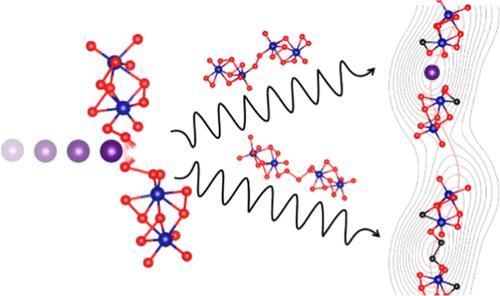非共调A14+2/3Ta8Se46+2/3化合物中两种结构类型的相互作用(A = Rb, Cs)
IF 4.7
2区 化学
Q1 CHEMISTRY, INORGANIC & NUCLEAR
引用次数: 0
摘要
非通约调制晶体是一种罕见的材料,众所周知,难以正确表征。基于M2Q11 (M = Nb, Ta;Q = S, Se)单元采用高温固态合成。利用超空间晶体学结合二次谐波产生测量,我们证实了这两种材料都是非中心对称的,属于超空间群P1(αβγ)0,而基本单元则属于C2/c。这些材料在结构上可以理解为两种已知结构类型A6Ta4Se22和A12Ta6Se35的有序组合(A = K, Rb, Cs)。虽然这两种调制化合物与上述已知相具有结构相似性,但它们代表了新的结构,而不是两相的字面组合,例如复合材料。对Rb14+2/3Ta8Se46+2/3和Cs14+2/3Ta8Se46+2/3进行了光学和热表征,显示出相同的带隙为1.63 eV,熔点分别为434和417°C。本文章由计算机程序翻译,如有差异,请以英文原文为准。

Interplay between Two Structure Types in the Incommensurately Modulated A14+2/3Ta8Se46+2/3 Compounds (A = Rb, Cs)
Incommensurately modulated crystals are a rare class of materials that are notoriously difficult to characterize properly. We have synthesized two new incommensurately modulated compounds, Rb14+2/3Ta8Se46+2/3 and Cs14+2/3Ta8Se46+2/3, based on the M2Q11 (M = Nb, Ta; Q = S, Se) unit using high-temperature solid-state synthesis. Using superspace crystallography in combination with second harmonic generation measurements, we confirmed both materials to be noncentrosymmetric, falling into the superspace group P1(αβγ)0, while the basic cell suggests C2/c. These materials can be structurally understood as ordered combinations of two known structure types, A6Ta4Se22 and A12Ta6Se35 (A = K, Rb, Cs). While both modulated compounds share structural similarities with the aforementioned known phases, they represent novel structures rather than a literal combination of the two phases, such as a composite. Additionally, both Rb14+2/3Ta8Se46+2/3 and Cs14+2/3Ta8Se46+2/3 were optically and thermally characterized, revealing identical band gaps of 1.63 eV and congruent melting points at 434 and 417 °C, respectively.
求助全文
通过发布文献求助,成功后即可免费获取论文全文。
去求助
来源期刊

Inorganic Chemistry
化学-无机化学与核化学
CiteScore
7.60
自引率
13.00%
发文量
1960
审稿时长
1.9 months
期刊介绍:
Inorganic Chemistry publishes fundamental studies in all phases of inorganic chemistry. Coverage includes experimental and theoretical reports on quantitative studies of structure and thermodynamics, kinetics, mechanisms of inorganic reactions, bioinorganic chemistry, and relevant aspects of organometallic chemistry, solid-state phenomena, and chemical bonding theory. Emphasis is placed on the synthesis, structure, thermodynamics, reactivity, spectroscopy, and bonding properties of significant new and known compounds.
 求助内容:
求助内容: 应助结果提醒方式:
应助结果提醒方式:


